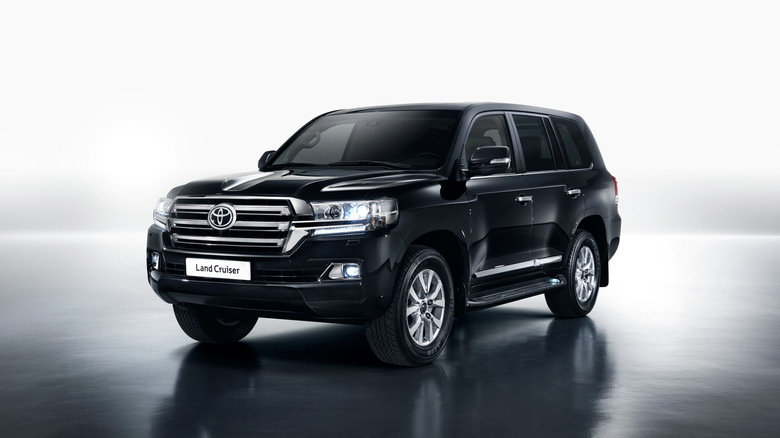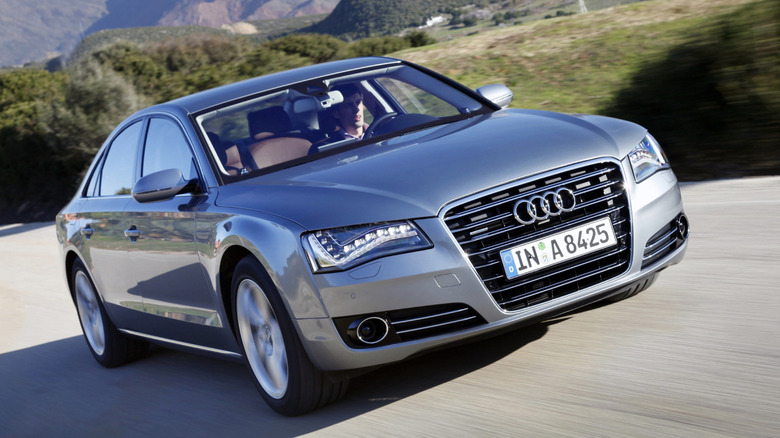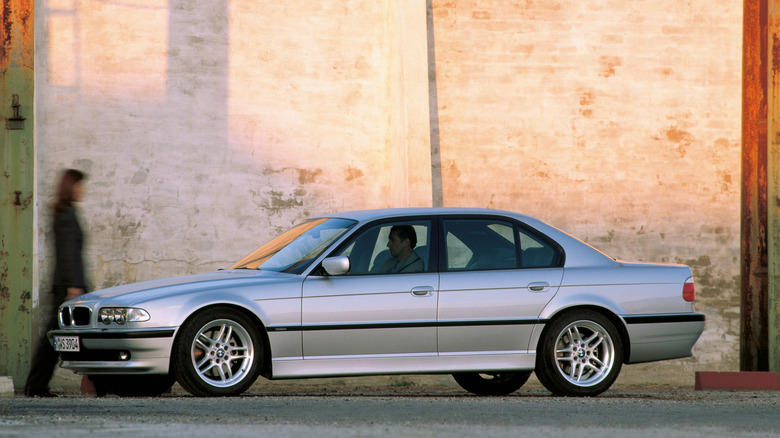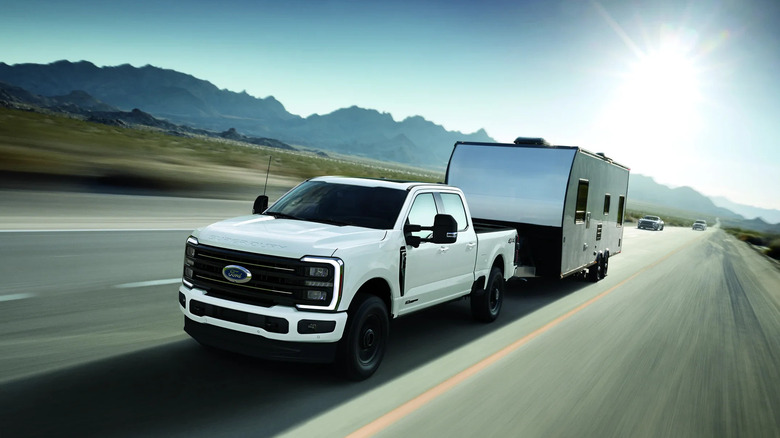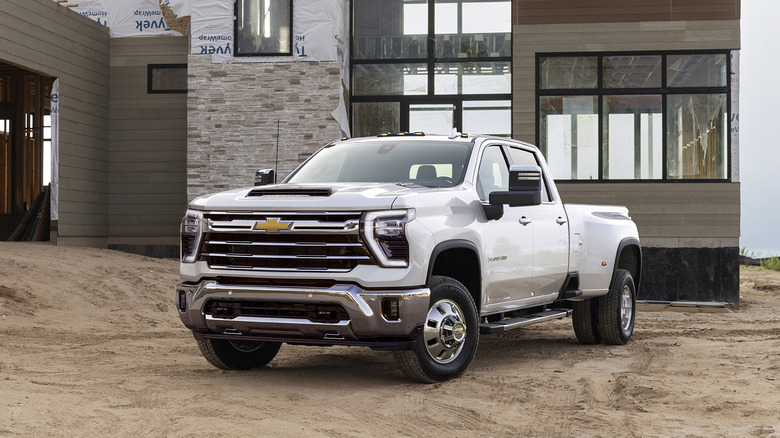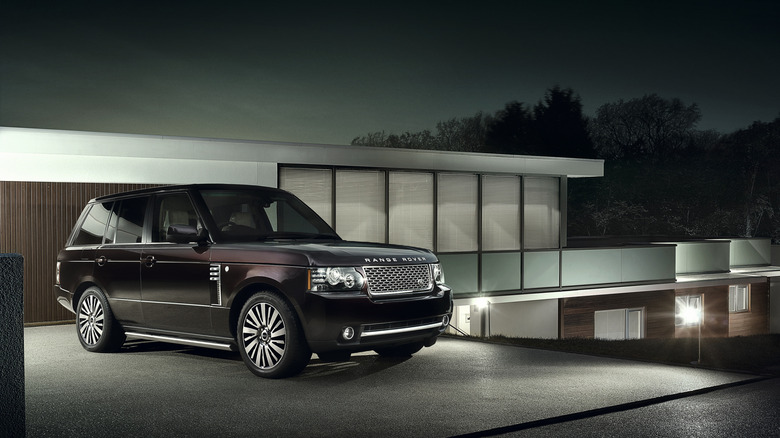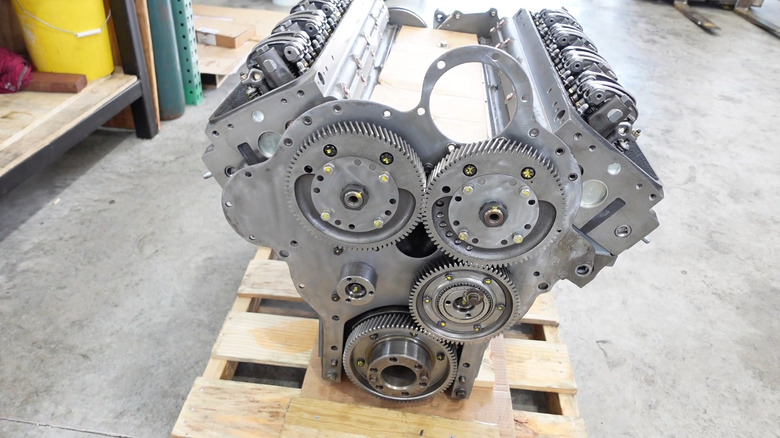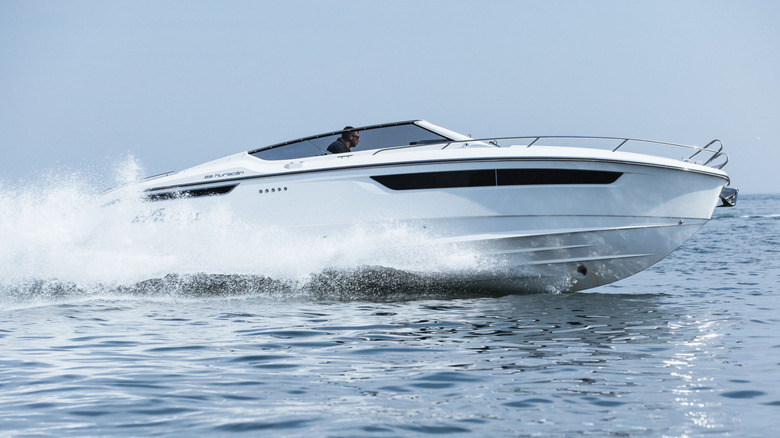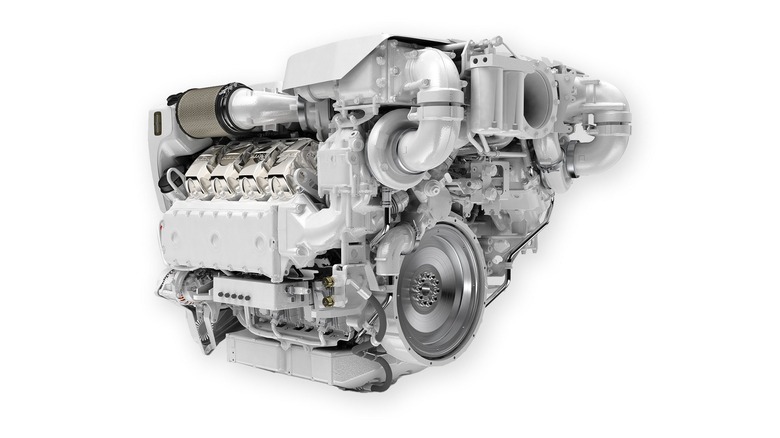13 Of The Best V8 Diesel Engines Ever Made
The V8 diesel engine didn't have its greatest introduction, at least in the passenger car world. Developed for buyers seeking higher efficiency, Oldsmobile's V8 diesel-powered Cutlass proved to be a complete lemon with probably the worst reliability record of any engine in history.
But don't let that fool you into thinking the industry hasn't produced great V8 diesel engines. In fact, the V8 diesel has been a staple in Scania's truck range since 1969, providing class-leading power figures for decades. These engines are also widely used in marine applications, the defense industry, and power generation, among others. Of course, some of the best V8 diesel engines ever made were also installed in passenger cars, providing outstanding performance and excellent fuel economy.
This piece will serve as a showcase for all those great V8 diesel engines, regardless of application. What makes a great V8 diesel engine, you might ask? Well, anything that sets it apart from its rivals, like reliability, specific power and torque output, efficiency, and advanced technology. Let's examine this closely!
Toyota 1VD-FTV 4.5L V8
The 1VD-FTV is Toyota's first and last V8 turbodiesel engine. But don't let that "lack of expertise" fool you into thinking it's a dud. This 4.5-liter behemoth is one of the best diesel engines Toyota ever built and a favorite among off-road enthusiasts globally, powering icons like the Land Cruiser 200 and 70 Series, and even the Lexus LX450d. It's a modern diesel with four valves per cylinder, a common rail system with nine-hole fuel injection, and one or two turbochargers, depending on the version. However, Toyota ensured the engine is stout by installing a forged steel crankshaft and high-strength steel connecting rods.
To the dissatisfaction of enthusiasts, Toyota discontinued the 1VD-FTV last year, replacing it with a 2.8-liter four-cylinder turbodiesel. The new engine has very big shoes to fill, because the 1VD-FTV is one of the most reliable V8 turbodiesel engines ever made. That's particularly true for the unstressed, single-turbo variant found in the Land Cruiser 70 Series, which produces 202 hp and 317 lb-ft of torque. With proper maintenance, it'll probably never break, especially in versions with the upgraded vacuum pump produced after 2011. Sadly, you can't buy the unbreakable Land Cruiser 70 Series in the U.S.
There's also a twin-turbocharged variant, which is quite the powerhouse with 282 hp and a massive 479 lb-ft of torque. In the Land Cruiser 200, this translates into a 0-62 mph (0-100 km/h) sprint of 8.2 seconds and a top speed of 131 mph. Most impressively, the big SUV is rated at 23 mpg combined.
Volkswagen/Audi 4.2L TDI V8
VW Group's V8 turbodiesel, launched in 2005, isn't as reliable as Toyota's 1VD-FTV. Shocker, we know. But it's still durable, with a much better reliability record than its 4.0-liter predecessor. It's also much more powerful than its Toyota rival. Audi used it in the first-gen Q7, where it made 326 hp and a frankly ridiculous 561 lb-ft of torque, thanks to its twin-turbo configuration and common rail direct injection system. The big Q7 sprinted to 62 mph in 6.6 seconds with this engine and maxed out at 147 mph.
Fast forward a decade, and the numbers became even more impressive. The 2018 Audi A8 4.2 TDI V8, for instance, packed 379 hp and an even higher 627 lb-ft of torque, enough for a 0-60 sprint of just 4.5 seconds. Yup, that's sports car performance in a large, diesel-powered luxury sedan. The most impressive figure is the 38 mpg fuel economy, which is astoundingly high for such a powerful engine.
After almost 15 years in service, the 4.2-liter V8 TDI was replaced by a more modern 4.0-liter unit. The new V8 TDI produced an astonishing 429 hp in the Audi SQ7 and truck-like 663 lb-ft of torque. Unfortunately, this engine was short-lived, so it didn't have enough time to reach the greatness of its predecessor.
BMW 3.9L M67D V8
Before the turn of the millennium, there was a turbodiesel war going on between German luxury automakers. Customers wanted more fuel-efficient cars but didn't want to sacrifice performance, so BMW, Audi, and Mercedes-Benz were all working on V8 diesel engines. BMW beat them to the punch, introducing the brand-new M67D in 1998. The engine was made by combining the cylinder blocks from two M47 four-cylinder diesels and had a capacity of 3.9 liters. The M67D was a DOHC design with 32 valves, common rail direct injection, and two turbochargers.
As a result, it had a solid output of 235 hp, or 242 hp at 4,700 rpm in the facelifted 1999 740D. However, the torque was way more impressive at 413 lb-ft and available between 1,750 and 2,500 rpm. In other words, the M67D pulled pretty much everywhere in the rev range. The 0-60 mph sprint of 8 seconds and 150 mph top speed were also impressive for the time. Still, that was only the beginning; in 2006, BMW introduced the upgraded 4.4-liter M67TUD44, which produced a healthy 325 hp and 553 lb-ft of torque.
You'd be surprised to hear that the M67D is also a durable engine. Yes, it's not among the five most reliable engines BMW has ever built, but it's still free of huge problems. It's hard to work on, though, and this is true for most German engines.
Navistar/Ford 7.3L Power Stroke V8
Navistar is one of the most well-known manufacturers of trucks, buses, and diesel engines in the U.S. So, naturally, when Ford wanted a reliable yet powerful V8 turbodiesel for its F-Series Heavy Duty trucks, it contacted Navistar. The collaboration gave us the 7.3-liter Power Stroke V8, one of the best diesel engines ever built. The reason? It's probably the most reliable American diesel engine.
See, the Navistar T444E came before the EPA put the hammer down on diesel engines. This engine didn't need the unreliable Exhaust Gas Recirculation (EGR) system to meet emission standards and only relied on a catalytic converter. Moreover, the Power Stroke V8 was equipped with a hydraulic fuel injection system sourced from Caterpillar, which provided injection pressures as high as 21,000 psi and proved more reliable than the competing common rail system. The injectors were largely responsible for the excellent reliability, as they only injected the fuel once per cycle, compared to multi-shot injection in common rail systems. To top it all off, Navistar used six bolts per cylinder, which made head gasket failures a thing of the past.
Sure, with power ranging from 210 hp to 275 hp in later versions, the 7.3-liter V8 isn't too powerful by today's standards. Even so, the 425-525 lb-ft of torque ensures excellent pulling power, making this engine a favorite among RV owners. The fact that well-maintained examples can easily surpass 350,000 miles only adds to the Navistar T444E's appeal.
Ford 6.7L Power Stroke V8
The Navistar T444E might be a champion for durability, but it can't hold a candle to Ford's latest 6.7-liter Power Stroke V8 in terms of power. Introduced in 2011, this brand-new engine arrived with 390 hp and 735 lb-ft of torque. Still, Ford wasn't standing still, and subsequent versions received significant power boosts.
Notably, in the 2025 Ford Super Duty trucks, the high-output version produces an astonishing 500 hp and a massive 1,200 lb-ft of torque. It's so potent that it brings the Ford F-250 behemoth to 60 mph in a mind-boggling 5.5 seconds. Oh, and it can also tow up to 40,000 pounds with a gooseneck hitch. No pickup truck has ever been more capable than the 6.7-liter Power Stroke in a Ford Super Duty.
While not as reliable as the Navistar turbodiesel, Ford's Power Stroke is a stout engine. It has some issues, like the vulnerable twin-piston Bosch fuel pump and turbocharger. Still, there are aftermarket solutions to mitigate these issues, like tougher fixed-geometry turbochargers and DCR fuel pumps, both of which can also boost power and torque. Even without the upgrades, the 6.7-liter Power Stroke is as reliable as its rivals, which is even more impressive when you consider the class-leading power and torque figures.
Chevrolet/GMC 6.6L Duramax V8
Ford's 6.7-liter Power Stroke V8 stole all the headlines with its 1,200 lb-ft of torque. Still, its closest rival, Chevy's 6.6-liter Duramax diesel, is a great engine in its own right. It's an advanced engine with common rail direct injection, four valves per cylinder, and a variable-vane turbocharger, resulting in high power and torque outputs.
Powering the Chevy Silverado and GMC Sierra Heavy Duty trucks, the Duramax is also a powerhouse, producing 470 hp and 975 lb-ft of torque in the latest 2025 versions. Yes, that's not as impressive as the Power Stroke, but these figures are still preposterous. The 6.6-second 0-60 sprint (Silverado 2500) is also mightily impressive, as is the 36,000-pound towing capacity with a gooseneck hitch.
More importantly, the 6.6-liter Duramax is one of the most reliable diesel engines ever built. GM expects that 95% of the engines on the road will reach 200,000 miles before a rebuild is necessary. Still, with proper maintenance, you can extract more than 300,000 miles from this engine. Because it's so robust, the 6.6-liter Duramax V8 is also very tuning-friendly, with simple ECU flashes bringing the output to 600+ hp. Adding new turbochargers will give you 700 hp to play with — at the wheels.
Land Rover/Ford 4.4L TDV8
We assure you, the Land Rover name in the title is not there by mistake. Yes, there was a brief time when the British SUV manufacturer had a reliable diesel engine in its lineup. But how did a brand that often sits at the bottom of reliability charts make such a good engine? They collaborated with Ford, a company that already knew how to make reliable V8 turbodiesels.
Ford developed two V8 turbodiesels from the AJD V8 family. The smaller 3.6-liter TDV8 was developed specifically for the Range Rover, while the larger 4.4-liter TDV8 was also used in the F-150 pickup truck. Both are good engines, but the larger one is significantly more potent and, crucially, more reliable. The 4.4-liter TDV8 arrived as a replacement for the 3.6-liter and was designed with a bigger emphasis on durability. It had chain-driven cams and a solid graphite iron block, giving it true high-mileage capability.
Power was also not an issue. With two turbochargers on board and common rail diesel injection, the 4.4-liter TDV8 was good for 313 hp and a meaty 516 lb-ft of torque available between 1,500 and 3,000 rpm. As a result, it brought the Range Rover L322 to 60 mph in 7.8 seconds and to a top speed of 131 mph. It was also very refined at speed, which was crucial for the Range Rover.
Detroit Diesel 8V71
Detroit remains one of the largest manufacturers of diesel engines globally. The company currently develops and produces diesel engines for semi-trucks and has also made some iconic marine engines. The 8V71 V8 diesel is certainly one of those engines. Introduced way back in 1938, the Detroit Diesel 71 series consisted of workhorse engines designed to stand the test of time.
Unlike other entries on this list, the 8V71 is a two-stroke engine with a capacity of 9.3 liters. It was available in two configurations: the supercharged version with a roots blower produces 318 hp at 2,100 rpm and 863 lb-ft of torque at just 1,200 rpm, while the turbocharged 8V71T produces a higher 385 hp at 2,100 rpm and an astonishing 1,120 lb-ft of torque at just 1,200 rpm.
Both versions are very reliable and easy to maintain. This isn't surprising, as two-stroke engines have a simpler construction that doesn't require a valvetrain. As a result, they were implemented in all sorts of vehicles, from buses and trucks to tugboats and fishing boats. In fact, they are still used in vintage yachts today. The 8V71 engines were even used as backup generators in hospitals and various industries.
Scania DC16 Series 16.4L V8
America is proud of its semis. Equipped with powerful inline-6 turbodiesel engines and striking designs, these towing rigs embody American culture. The thing is, though, Europe has better semis. Not only are they more capable of navigating tight spaces but also more powerful. Heck, it's not even close.
Case in point: Scania's latest DC16 turbodiesel — the most advanced semi engine in the world. This 16.4-liter V8 behemoth is available in several tunes, with the most powerful one producing a world-leading 759 hp and Earth-shattering 2,729 lb-ft of torque. Maximum torque is available between 1,000 and 1,450 rpm, meaning pulling power is available from the get-go. American semi diesel engines can't compare; the Cummins 14.9-liter X15 produces 605 hp, while Detroit's 15.6-liter DD16 tops out at 600 hp.
Even more impressive is the fact that Scania achieved all that while making the engine less complex. The DC16 has no diesel EGR (Exhaust Gas Recirculation) valve, which has proven a pain in modern diesel engines regarding reliability. Instead, Scania fully relies on a more advanced AdBlue twin-dosing selective catalytic reduction system to control emissions. Furthermore, the engine has a fixed-geometry turbocharger with ball bearings, which is also more reliable than its more advanced variable-geometry counterpart.
CAT 3408 V8
CAT's 3408 V8 is another engine known for being super reliable and durable. Its lifespan is rated at a ridiculous 16,000 hours, making it one of the longest-lasting diesel engines. Moreover, CAT keeps producing parts to help owners keep using these monsters, even though production finished in 1985.
Like Detroit Diesel's 8V71, the 3408 is mostly used in marine applications, including luxury yachts, fishing boats, offshore vessels, and tug boats. However, thanks to its stout build, this four-stroke V8 diesel is also used in industrial applications and even trucks, like the Peterbilt 359. The power and torque figures are also different depending on the application. The smaller CAT 3408 has a capacity of 14.6 liters and is available in naturally aspirated or turbocharged form. It produces up to 400 hp, which is quite powerful for a four-stroke marine engine.
However, it's the industrial and backup power units that really push things to a whole new level. The 18-liter 3408 variant is a true horsepower beast and comes with a standard turbocharger and aftercooling. It's available in 600 hp, 700 hp, and 800 hp configurations. Even more impressive is the torque output of a whopping 2,000+ lb-ft.
Yanmar 8LV 4.5L V8
Yanmar is a Japanese manufacturer that has specialized in producing engines ever since it was established in 1912. Initially, Yanmar produced engines for agricultural vehicles, but today it has an extensive portfolio that covers marine, compact equipment, industrial engines, power generation, and energy systems. Yanmar's 500cc single-cylinder diesel engine even found its way into this supercharged Frankendiesel motorcycle.
On the other end of the spectrum sits Yanmar's 4.5-liter 8LV — a state-of-the-art V8 twin-turbo diesel with common rail direct injection, designed specifically for sport boats and luxury cruisers. It's available in 320 hp, 350 hp, and 370 hp tunes, all peaking at a high 3,800 rpm. Still, you can enjoy double the power by installing two 8LVs. Regardless, you will be getting the best power-to-weight ratio in its category; the 8LV weighs just 959 pounds dry.
But it's not just about power — the 8LV can also crawl your boat at idle (550 rpm) for those silent marina arrivals while delivering quiet and vibration-free operation at all engine speeds. Crucially, the Yanmar 8LV engine is designed to be reliable and durable. Yanmar engines in general are known for being robust and well-made, and we've no reason to believe the 8LV is any different. Overall, it's no exaggeration to say that the 8LV is currently one of the best marine diesel engines.
MAN 16.2L V8-1300
With a capacity of 16.2 liters, MAN's marine V8 turbodiesel engine is developed specifically for larger yachts and fishing boats. But what matters is what this engine does with its capacity — the V8-1300 is currently the marine diesel engine with the highest power density at 79 hp per liter.
In other words, it produces a cracking 1,300 hp at just 2,300 rpm. The torque figure of 3,208 lb-ft, available between 1,200 and 2,100 rpm, is perhaps even more remarkable. But the most impressive thing is that MAN managed to pack all that power into a relatively compact engine that weighs just 4,145 pounds.
To achieve those impressive figures, MAN improved the already impressive V8-1200 in several key areas. The 1,300-hp version received improved injectors, new turbochargers, and redesigned cylinder heads with a new cooling system. Thanks to these improvements, the V8-1300 not only produces class-leading power but is also compliant with the latest EPA Tier 3 recreational, IMO Tier II, and RCD 2013/53/EC, 97/68/EC exhaust gas emissions standards. Oh, but the MAN V8-1300 is just the mid-level offering; the German truck maker also produces a V12 turbodiesel beast with a capacity of 24 liters and an absurd 2,000 hp.
Cummins V903 14.8L V8
For this last entry, we'll have a closer look at one of America's best defense diesel engines — the Cummins V903. This 14.8-liter, 90-degree V8 behemoth is built on an already proven design that has served the military for decades. Most notably, the Cummins V903 powers the Bradley Fighting Vehicle, an M2 infantry fighting vehicle designed to cover dismounted troops and suppress enemy tanks. However, you can buy a Cummins V903 for yourself and use it in marine or truck applications.
In fact, the V903 design was primarily used in trucks in the 1970s and was known for being very durable. It produced up to 320 hp back then, but it could go beyond 500,000 miles without an overhaul. However, the V903 was improved significantly over the years, resulting in more power and even higher reliability. Today, the V903 has Cummins' Electronically Controlled CP-STC Fuel System, turbocharging, and aftercooling. As a result, it produces an outstanding 760 hp and 1,570 lb-ft of torque while weighing just 2,580 pounds.

